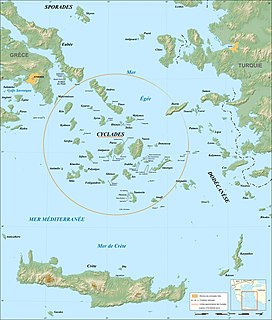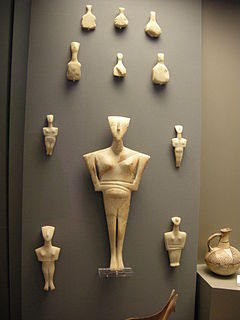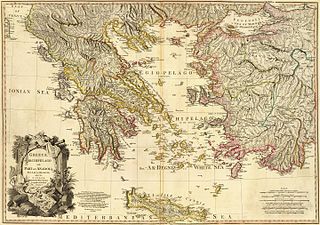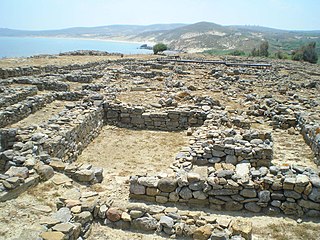 W
WCycladic culture was a Bronze Age culture found throughout the islands of the Cyclades in the Aegean Sea. In chronological terms, it is a relative dating system for artefacts which broadly complements Helladic chronology and Minoan chronology (Crete) during the same period of time.
 W
WThe ancient Cycladic culture flourished in the islands of the Aegean Sea from c. 3300 to 1100 BCE. Along with the Minoan civilization and Mycenaean Greece, the Cycladic people are counted among the three major Aegean cultures. Cycladic art therefore comprises one of the three main branches of Aegean art.
 W
WThe Fat Lady of Saliagos is a marble figure from the Aegean Neolithic period from Saliagos between Paros and Antiparos.
 W
WFrying pans is the descriptive name for Early Cycladic II artifacts from the Aegean Islands, flat skillets with a "handle", usually made from earthenware but sometimes stone. They are found especially during the Cycladic Grotta-Pelos and Keros-Syros cultures. Their purpose remains unknown, although they are usually interpreted as prestige goods.
 W
WThe Nicholas P. Goulandris Foundation - Museum of Cycladic Art is a museum of Athens. It houses a notable collection of artifacts of Cycladic art.
 W
WThe Grotta-Pelos culture refers to a "cultural" dating system used for part of the early Bronze Age in Greece. Specifically, it is the period that marks the beginning of the so-called Cycladic culture and spans the Neolithic period in the late 4th millennium BC, continuing in the Bronze Age to about 2700 BC. The term was coined by Colin Renfrew, who named it after the sites of Grotta and Pelos on the Cycladic islands of Naxos and Milos, respectively. Other archaeologists prefer a "chronological" dating system and refer to this period as the Early Cycladic I (ECI).
 W
WKeros (Greek: Κέρος; anciently, Keria or Kereia is an uninhabited Greek island in the Cyclades about 10 km southeast of Naxos. Administratively it is part of the community of Koufonisia. It has an area of 15 km2 and its highest point is 432 m. It was an important site to the Cycladic civilization that flourished around 2500 BC. It is now forbidden to land in Keros.
 W
WThe Keros-Syros culture is named after two islands in the Cyclades — Keros and Syros. This culture flourished during the Early Cycladic II period of the Cycladic civilization. The trade relations of this culture spread far and wide from the Greek mainland to Crete and Asia Minor.
 W
WVarious outdated theories have postulated waves of migration during the Middle Bronze Age in the ancient Near East. Drews and Dietrich connect these alleged "mass migrations" with the coming of the Greeks, moving from former settlements into the southern and central Balkans, displacing the former pre-Greek inhabitants of Greece. Mallaart makes reference to a supposed migration of the Hittites to their earliest known home in Kültepe during the same period.
 W
WThe name Pelasgians was used by classical Greek writers to refer either to the ancestors of the Greeks, or to all the inhabitants of Greece before the emergence or arrival of the Greeks. In general, "Pelasgian" has come to mean more broadly all the indigenous inhabitants of the Aegean Sea region and their cultures, "a hold-all term for any ancient, primitive and presumably indigenous people in the Greek world".
 W
WPhylakopi, located at the northern coast of the island of Milos, is one of the most important Bronze Age settlements in the Aegean and especially in the Cyclades. The importance of Phylakopi is in its continuity throughout the Bronze Age and because of this, it is the type-site for the investigation of several chronological periods of the Aegean Bronze Age.
 W
WThe Phylakopi I culture refers to a "cultural" dating system used for the Cycladic culture that flourished during the early Bronze Age in Greece. It spans the period ca. 2300-2000 BC and was named by Colin Renfrew, after the settlement of Phylakopi on the Cycladic island of Milos. Other archaeologists describe this period as the Early Cycladic III (ECIII).
 W
WPoliochne, often cited under its modern name Poliochni, was an ancient settlement on the east coast of the island of Lemnos. It was settled in the Late Chalcolithic and earliest Aegean Bronze Age and is believed to be one of the most ancient towns in Europe, preceding Troy I. Anatolian features of the earliest layers were affected by cultural influences from Helladic Greece, about the start of Early Helladic II, ca. 2500 BC.
 W
WSaliagos is an islet in the Greek island group of Cyclades. It is the first early farming site and one of the oldest settlements of the Cycladic culture. Saliagos is only 110 to 70 meters in size and is situated between Antiparos and Paros, along with several other uninhabited islands.
 W
WSkarkos is an early Bronze Age settlement on the island of Ios in Greece. Owing to its well preserved state, Skarkos is one of the most important prehistoric sites in the Aegean and especially the Cyclades.